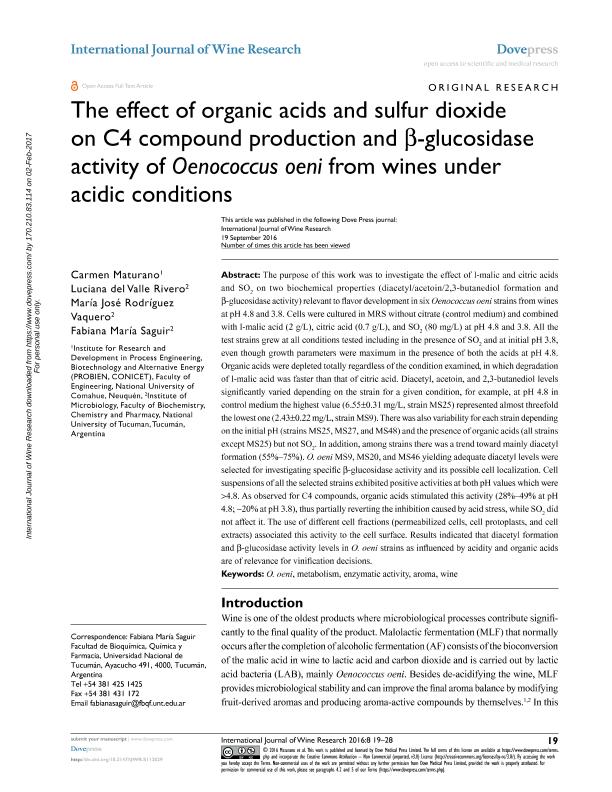Artículo
The effect of organic acids and sulfur dioxide on C4 compound production and ß-glucosidase activity of Oenococcus oeni from wines under acidic conditions
Maturano, Ramona del Carmen ; Rivero, Luciana del Valle
; Rivero, Luciana del Valle ; Rodriguez Vaquero, Maria Jose
; Rodriguez Vaquero, Maria Jose ; Saguir de Zucal, Fabiana Maria
; Saguir de Zucal, Fabiana Maria
 ; Rivero, Luciana del Valle
; Rivero, Luciana del Valle ; Rodriguez Vaquero, Maria Jose
; Rodriguez Vaquero, Maria Jose ; Saguir de Zucal, Fabiana Maria
; Saguir de Zucal, Fabiana Maria
Fecha de publicación:
06/2016
Editorial:
Dove Press
Revista:
International Journal of Wine Research
ISSN:
1179-1403
Idioma:
Inglés
Tipo de recurso:
Artículo publicado
Clasificación temática:
Resumen
The purpose of this work was to investigate the effect of l-malic and citric acids and SO2 on two biochemical properties (diacetyl/acetoin/2,3-butanediol formation and β-glucosidase activity) relevant to flavor development in six Oenococcus oeni strains from wines at pH 4.8 and 3.8. Cells were cultured in MRS without citrate (control medium) and combined with l-malic acid (2 g/L), citric acid (0.7 g/L), and SO2 (80 mg/L) at pH 4.8 and 3.8. All the test strains grew at all conditions tested including in the presence of SO2 and at initial pH 3.8, even though growth parameters were maximum in the presence of both the acids at pH 4.8. Organic acids were depleted totally regardless of the condition examined, in which degradation of l-malic acid was faster than that of citric acid. Diacetyl, acetoin, and 2,3-butanediol levels significantly varied depending on the strain for a given condition, for example, at pH 4.8 in control medium the highest value (6.55±0.31 mg/L, strain MS25) represented almost threefold the lowest one (2.43±0.22 mg/L, strain MS9). There was also variability for each strain depending on the initial pH (strains MS25, MS27, and MS48) and the presence of organic acids (all strains except MS25) but not SO2. In addition, among strains there was a trend toward mainly diacetyl formation (55%-75%). O. oeni MS9, MS20, and MS46 yielding adequate diacetyl levels were selected for investigating specific β-glucosidase activity and its possible cell localization. Cell suspensions of all the selected strains exhibited positive activities at both pH values which were > 4.8. As observed for C4 compounds, organic acids stimulated this activity (28%-49% at pH 4.8; ~20% at pH 3.8), thus partially reverting the inhibition caused by acid stress, while SO2 did not affect it. The use of different cell fractions (permeabilized cells, cell protoplasts, and cell extracts) associated this activity to the cell surface. Results indicated that diacetyl formation and β-glucosidase activity levels in O. oeni strains as influenced by acidity and organic acids are of relevance for vinification decisions.
Palabras clave:
Aroma
,
Enzymatic Activity
,
Metabolism
,
O. Oeni
,
Wine
Archivos asociados
Licencia
Identificadores
Colecciones
Articulos(CCT - NOA SUR)
Articulos de CTRO.CIENTIFICO TECNOL.CONICET - NOA SUR
Articulos de CTRO.CIENTIFICO TECNOL.CONICET - NOA SUR
Articulos(PROBIEN)
Articulos de INST. DE INVESTIGACION Y DES. EN ING. DE PROCESOS, BIOTECNOLOGIA Y ENERGIAS ALTERNATIVAS
Articulos de INST. DE INVESTIGACION Y DES. EN ING. DE PROCESOS, BIOTECNOLOGIA Y ENERGIAS ALTERNATIVAS
Citación
Maturano, Ramona del Carmen; Rivero, Luciana del Valle; Rodriguez Vaquero, Maria Jose; Saguir de Zucal, Fabiana Maria; The effect of organic acids and sulfur dioxide on C4 compound production and ß-glucosidase activity of Oenococcus oeni from wines under acidic conditions; Dove Press; International Journal of Wine Research; 8; 6-2016; 19-28
Compartir
Altmétricas



